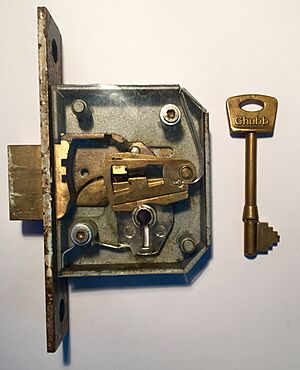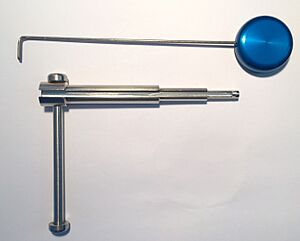Lever tumbler lock facts for kids
A lever tumbler lock is a type of lock that uses a set of special metal plates called levers. These levers stop the lock's bolt from moving. For the lock to open, each lever must be lifted to exactly the right height by the key. If a lever isn't lifted enough, or is lifted too far, the bolt won't move, and the lock will stay shut.
Contents
The History of Lever Locks
The clever design for "double acting" lever tumbler locks was invented in 1778 by Robert Barron in England. His invention made locks much more secure. With Barron's locks, the levers had a special slot. This meant you had to lift each lever to a very specific height. If you lifted it too much, it wouldn't work, just like not lifting it enough. This smart lock design is still used today on doors in places like Europe, Africa, and South America.
How Lever Locks Work
Inside a lever lock, you'll find several levers. These are usually made from strong, non-rusting metals. Each lever has to be lifted to a certain height by your key. This allows the locking bolt to slide past.
The key has different cuts, or "bitting," that match the unique shape of the levers. When you turn the key, these cuts push each lever up to its correct spot. Each lever has a small opening called a "gate" or "pocket." When all the levers are at the right height, these gates line up perfectly. This creates a clear path for a part of the bolt, called the "stump" or "fence," to move through. This movement is what unlocks the door.
Most lever locks use a bitted key, which is a key with a solid shaft and a specific shape at the end. Some very secure locks, like those on safes, might use a "double-bitted key." These keys have cuts on both sides.
Three-Lever Locks
A three-lever lock is a common type of lever lock. However, it's usually used for places that don't need super high security, like inside doors in a house. This is because they have fewer levers, which means there are fewer possible key combinations. This makes them less secure than locks with more levers.
Five-Lever Locks
A five-lever lock is much more secure than a three-lever lock. These locks are often suggested by police and are usually required for home insurance in many places. There are different levels of security for these locks. For example, in the UK, the British Standard (BS3621:2007) is often needed for insurance. This standard means the lock's bolt must extend at least 20 millimeters into the door frame, making it harder to force open.
Most BS3621 locks also have special features to make them even safer. These include parts that make lock picking harder and strong, hardened bolts and metal plates that resist drilling.
How Lever Locks Can Be Attacked
Lever tumbler locks can sometimes be opened without a key using a tool called a curtain pick. This tool is put into the keyhole. Then, a small amount of pressure is put on the locking bolt. The pick is then used to carefully lift each lever inside the lock to the correct height, one by one. Once all the levers are lined up, the bolt can slide open.
Higher security lever locks, like the five-lever type, often have special notches cut into their levers. These notches are designed to catch the locking bolt if someone tries to pick the lock. This stops the bolt from moving and makes picking much harder. This is similar to how security pins work in a pin tumbler lock.
The Chubb detector lock is a special kind of lever lock. It was designed to actually "detect" if someone was trying to pick it. If a picking attempt was made, the lock would jam, making it even harder to open.
Lever locks can also be drilled open. However, it's usually hard to know exactly where to drill because the lock mechanism is often hidden inside the door. Because of this, people often need a special guide or template to mark the correct drilling spot.
See also
- Warded lock
- Mortise lock
- Lock picking




